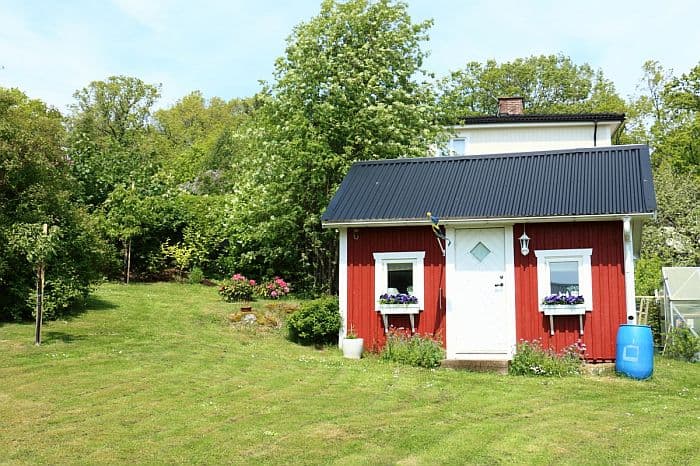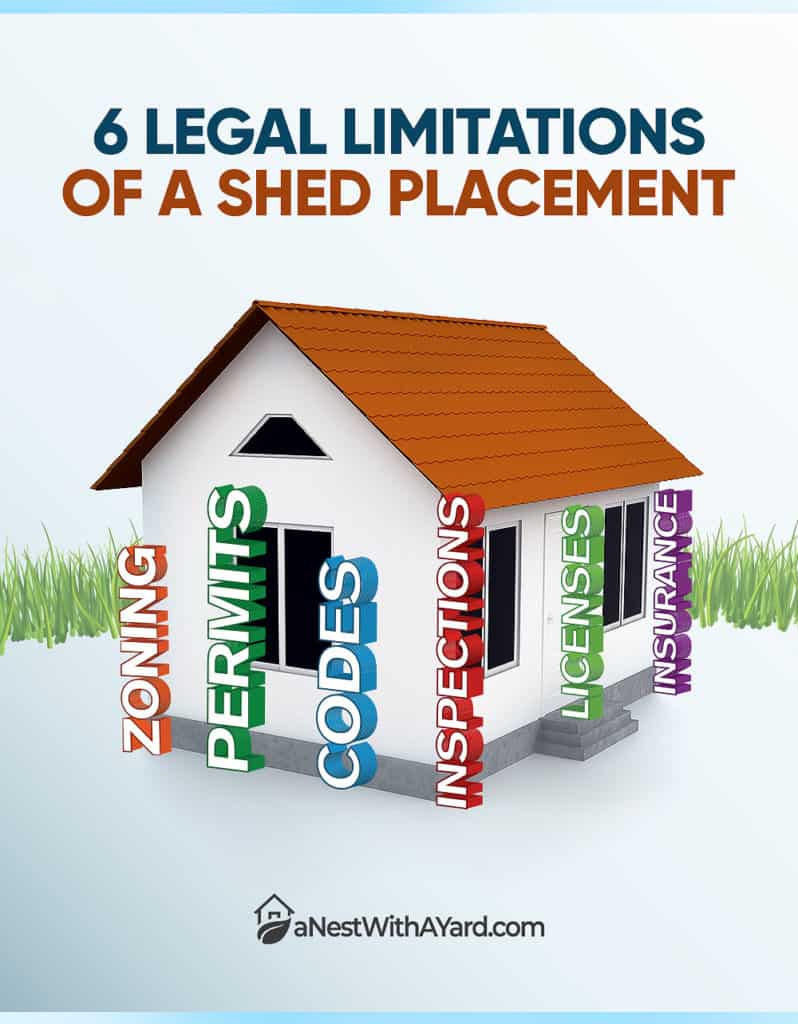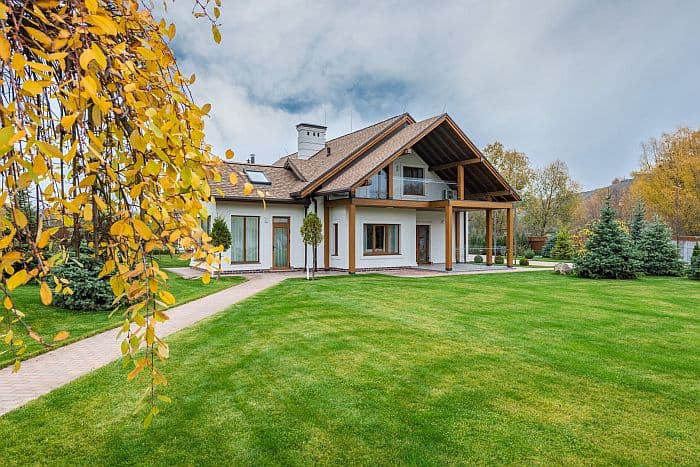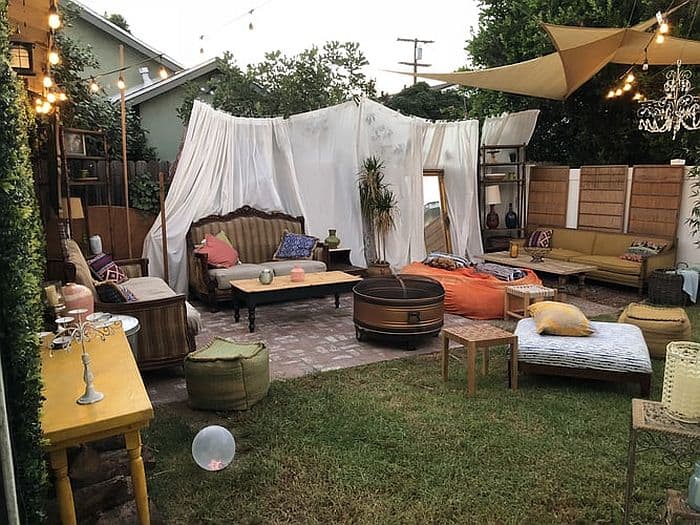When deciding on your shed placement in your backyard, you will need to consider various factors. Primarily, you must check zoning regulations and other legal terms that dictate how close your shed can be to your house. You should also consider your shed’s purpose, usable space, and terrain.
Are you ready to install a new garden shed in your backyard? You might get caught up in the excitement of designing your new man cave or storage space and not consider its placement. However, it is an essential factor to think about.
The last thing you want is to set up your shed, only for it to be unusable or illegal in its placement. Since it’s considered to be an accessory building, it is subject to local regulations that you need to follow.
That’s why I’ve put together this shed placement article. We’ll look at if you can put a shed next to the house and other factors to consider.
Contents
How Will You Use Your Shed?

First, you need to decide how you will use your backyard shed. Its purpose can have a significant impact on where you should place it.
Storage
Whether you want to store your lawn mower, firewood, valuable power tools, garbage, or other items, storage is one of the most common functions of a garden shed. Depending on what you want to store, there are some space limitations you may need to consider.
For example, if you live in an area where it snows in the winter, you probably don’t want to store your snow blower and shovel far from your house. By placing the shed closer to your house, you can make the tools a lot more accessible.
However, large items like lawn mowers may need more space to maneuver them. Whatever you plan to store, consider how you will move it around your backyard. If you want to keep a motorbike, you will also need to factor in space for a ramp.
Workshop
A workshop is an excellent use for a garden sheds. You can work on your projects without creating noise and mess inside your house. However, you will likely need access to electricity.
The same applies if you want to set up a TV, speakers, or another entertainment system in your man cave.
Therefore, make sure that your shed placement is not too far from the main building. Otherwise, you may need to install another electricity line, which can be time-consuming and costly.
Office
If you want to convert your shed into a home office, then peace and quiet may be your highest priorities. It can be difficult to concentrate with background noise. Therefore, you should place your shed far from roads, neighbors, air conditioning units, and other potential noise pollution.
However, you will also need to have access to electricity, so it may be a compromise between connection and silence.
What Are The Legal Limitations?

Local governments and councils usually have specific regulations for where and how you can construct structures like sheds. I recommend checking directly with your local council for the most up-to-date rules.
These are some of the legal factors you will need to consider. They may apply to traditional sheds and other structures, like a converted gazebo.
Permits
Depending on the size of the shed and your location, you may need a building permit for your shed. This is usually not applicable to small, simple sheds, but you may need a license if:
- You want to run an electricity line to your shed.
- You want to build a concrete foundation.
- You want to live in the shed or use it for commercial purposes.
- Your shed is very wide or tall.
Therefore, you should always check if you need a zoning permit before buying or assembling your shed.
Distance From Your Property Lines
Like zoning permits, each location has different restrictions on how close your shed can be to your back and side property limits.
Many locations stipulate that your shed must be at least 10 feet (3m) from the back and 15 feet (4.5m) from the sides of your property. Taller sheds may also need to be further away from your fence, with a distance of 5 feet (1.5m) as pretty standard.
If you do not follow these guidelines, your council may force you to move the shed, which could be incredibly expensive.
Building Separation
You have restrictions on how close you can have your shed next to the house. This distance is called building separation, and it dictates how far away you must build your accessory building (shed).
According to the International Zoning Code, the accessory building needs to be at least 10 feet (3m) away from your main house. It also stipulates that storage sheds should only be in your backyard and not the front.
This distance can depend on the fire resistance level of your house and shed walls. Your local council may also apply additional restrictions.
Yard Coverage
Each municipality limits how much of your backyard you can cover with a shed. This could potentially be an issue if you want to purchase a large building for a home office, man cave, or oversized storage space.
Again, this can depend on where you live, but most councils do not allow you to cover more than 50 percent of your backyard with a shed.
Homeowners Association Regulations
Other than the municipal laws, you may also need to obey Homeowners Association (HOA) rules. These organizations exist to maintain and increase the value of properties in an area, so they may place aesthetic restrictions.
Your HOA may not allow particular sizes or placements of sheds because it believes that it makes your property less attractive. A contract with an HOA is binding, and it may try to sue you if you do not obey your agreements.
Therefore, if you are part of an HOA, you should contact them directly to see if they have additional restrictions.
What Is The Condition Of Your Backyard?

The layout and condition of your backyard may restrict where you can put your shed. You want to avoid unstable foundations or hazards, so there are several factors to consider.
Terrain
If you have sand in your backyard, this is not an ideal position for your garden shed. It does not provide a stable surface, and it can move over time, potentially destabilizing or collapsing your structure.
Rocky surfaces are also tricky for shed placement. You may not be able to create a smooth and stable base for your shed, so you may have to build an additional foundation. If you cannot avoid bumpy terrain, it could be more expensive to install your shed.
Clay earth can be an excellent base for your garden shed. However, it has poor drainage, and so water may collect. Therefore, it may not be the best position for your shed if it is at the bottom of a slope.
In general, you want to choose a flat piece of land. This even surface provides the greatest stability and prevents the structure from collapsing.
Trees
Building your shed underneath a large tree is generally not a good idea. If there is strong wind or a storm, the tree can drop branches or uproot entirely and crush your shed. The fallen leaves may also accumulate on top of the roof, weighing down the structure.
You should also be mindful of tree roots. They can grow under the shed and can disrupt the structure from underneath it. Therefore, avoid installing your shed close to large trees and plants.
Drainage
If you have a sloped yard, the water probably collects in certain parts of the land. This is especially true if you live in a wet climate, and it can create puddles around your backyard.
Therefore, you will need to build your shed away from potential puddles. Otherwise, the water can rot the wood or cause rust on a metal surface.
Exposure To Light And Heat
If you will be inside your shed to use it as an office or workshop, you need to think about its internal temperature. In spring and summer, the hot sun can heat your shed and make it uncomfortable to be inside.
Therefore, you may want to place your shed out of the direct sun, with a shade source like a tree. However, as mentioned above, remember to leave some distance in case of falling leaves or branches.
Septic Beds And Wires
Many houses have septic systems underground. If you build your shed on top, you won’t be able to access it in case of any sewerage problems. There may also be electrical wires or other plumbing pipes that run across your property.
Therefore, you must make sure that the space under your shed is free from essential structures.
What Is The Design Of Your Outdoor Space?

Lastly, you should consider aesthetics when deciding where to put your shed. For example, placing the structure too close to one of your house windows could block the beautiful views of your backyard.
You also want to make sure that you leave enough room for your kids and pets to play in the backyard. If you take up all the grassy area with your shed, you restrict your family’s ability to enjoy your backyard.
If you do not have a very visual mind, you may like to consult a landscape gardener or architect. They can look at your outdoor space and help you decide where a garden shed would look best.
FAQs
Where Should A Shed Be Placed On Property?
A shed should be placed at least 10 feet (3m) away from your back property line and 15 feet (4.5m) away from the side property line in most locations. You should also consider how you will use your shed, other space limitations, the condition of your terrain, and aesthetics.
How Close To A House Can A Shed Be?
You must avoid building a shed too close to your house. Generally, a shed must be at least 10 feet (3m) away from your home. However, you should check your location’s specific zoning laws and regulations, as there may be additional limitations.
The Verdict: Can I Put A Shed Right Next To My House?
In conclusion, you generally cannot directly put a shed next to the house. There are international and local council guidelines determining how far the structure must be from your home and property lines.
You should also consider the layout of your garden, its terrain, and the shed’s purpose when you decide on its placement. By taking the time to properly research and plan, you shouldn’t run into any issues.
Do you have any further questions about shed placement? Let me know in the comments section. Thanks for reading!

wanted to put a 12′ x 24′ shed in my front yard plenty of room in front of the house, my own property and outside city limits and no neighborhood.
We live in Quebec by a lake, we are putting up a 10′ by 10′ bunkie and wondering how many feet we need to be away from waterfront?
hello!
I want to put a small storage 4×8’ and 6ft height (just premade metal and resin wall, from costco) on the side of my house behind the fence (backyard). i wanted to put it one foot away from the wall. it has no electricity or plumbing, and storage for office paper boxes. i am in southern california. do you think something this small is okay to build ?
thanks if anyone decides to give a professional input!
david